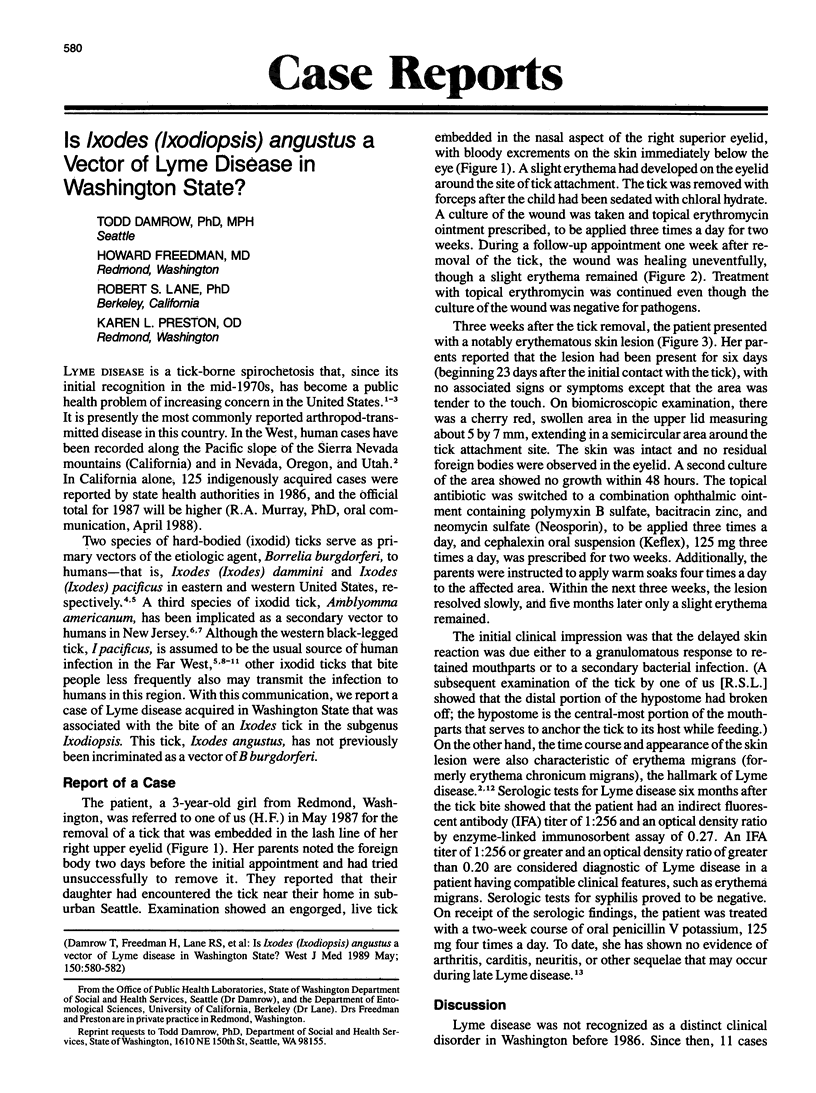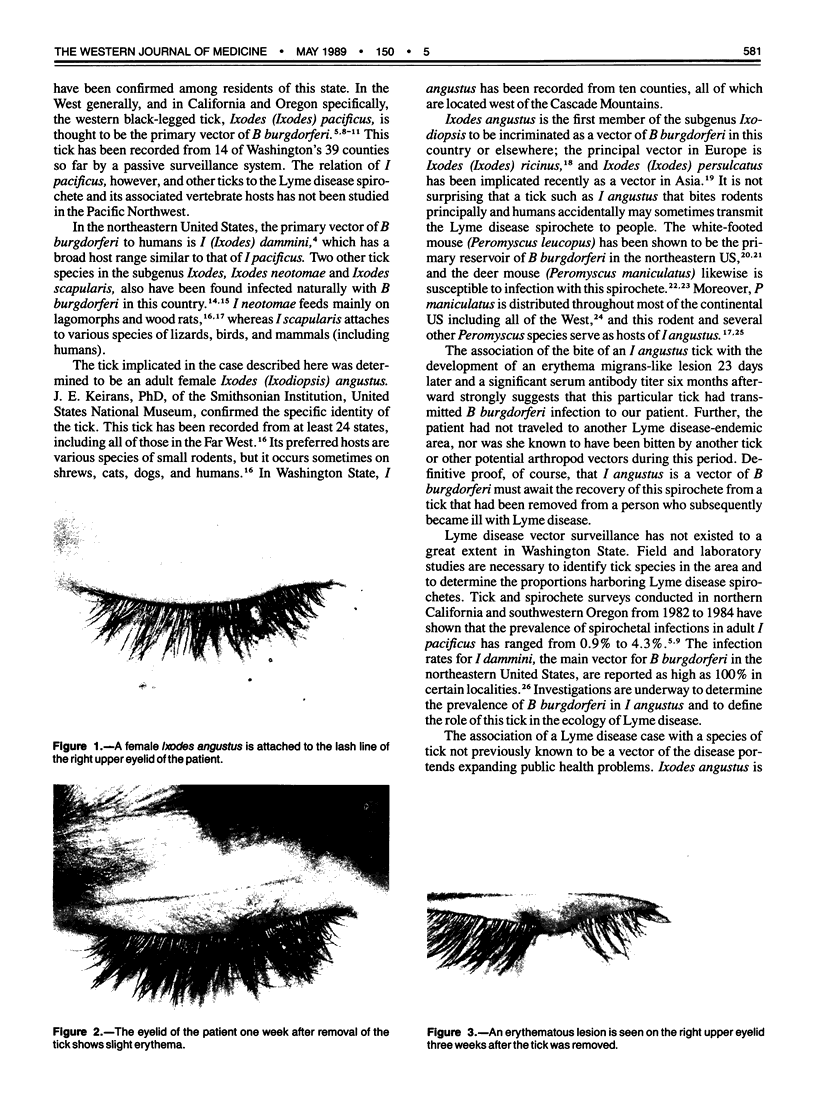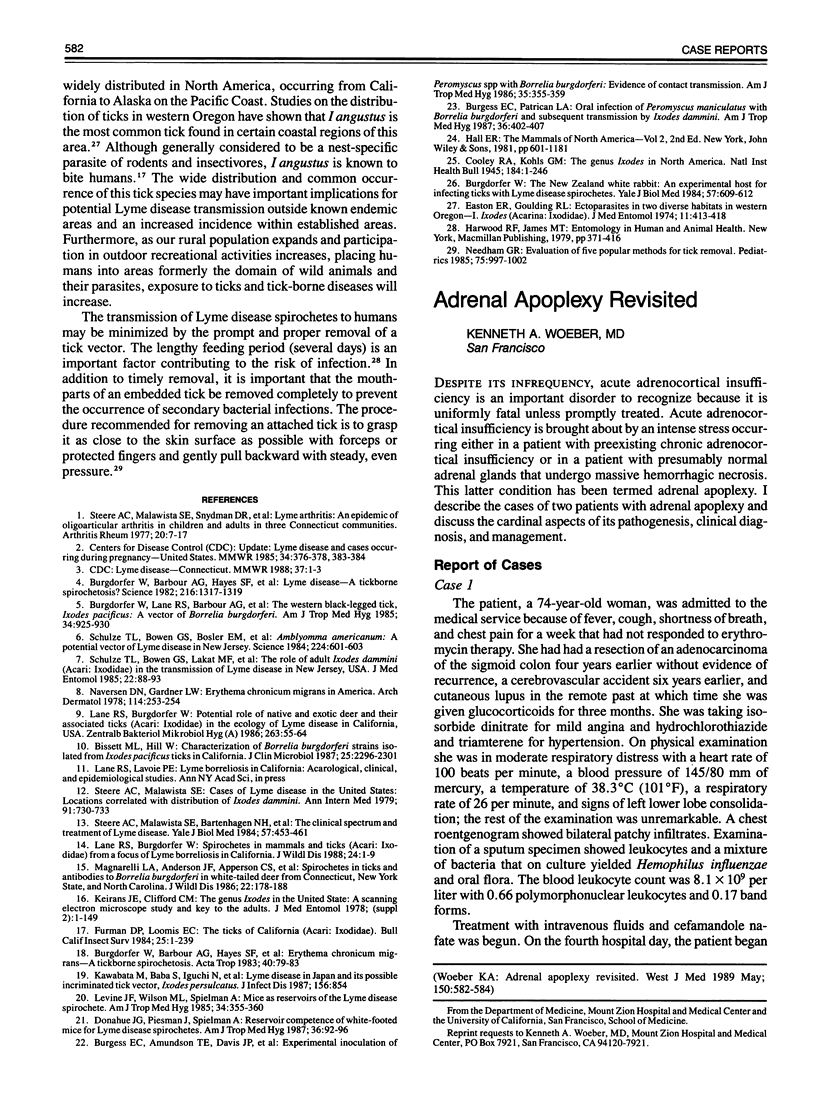Full text
PDF


Images in this article
Selected References
These references are in PubMed. This may not be the complete list of references from this article.
- Bissett M. L., Hill W. Characterization of Borrelia burgdorferi strains isolated from Ixodes pacificus ticks in California. J Clin Microbiol. 1987 Dec;25(12):2296–2301. doi: 10.1128/jcm.25.12.2296-2301.1987. [DOI] [PMC free article] [PubMed] [Google Scholar]
- Burgdorfer W., Barbour A. G., Hayes S. F., Benach J. L., Grunwaldt E., Davis J. P. Lyme disease-a tick-borne spirochetosis? Science. 1982 Jun 18;216(4552):1317–1319. doi: 10.1126/science.7043737. [DOI] [PubMed] [Google Scholar]
- Burgdorfer W., Barbour A. G., Hayes S. F., Péter O., Aeschlimann A. Erythema chronicum migrans--a tickborne spirochetosis. Acta Trop. 1983 Mar;40(1):79–83. [PubMed] [Google Scholar]
- Burgdorfer W., Lane R. S., Barbour A. G., Gresbrink R. A., Anderson J. R. The western black-legged tick, Ixodes pacificus: a vector of Borrelia burgdorferi. Am J Trop Med Hyg. 1985 Sep;34(5):925–930. doi: 10.4269/ajtmh.1985.34.925. [DOI] [PubMed] [Google Scholar]
- Burgdorfer W. The New Zealand white rabbit: an experimental host for infecting ticks with Lyme disease spirochetes. Yale J Biol Med. 1984 Jul-Aug;57(4):609–612. [PMC free article] [PubMed] [Google Scholar]
- Burgess E. C., Amundson T. E., Davis J. P., Kaslow R. A., Edelman R. Experimental inoculation of Peromyscus spp. with Borrelia burgdorferi: evidence of contact transmission. Am J Trop Med Hyg. 1986 Mar;35(2):355–359. doi: 10.4269/ajtmh.1986.35.355. [DOI] [PubMed] [Google Scholar]
- Burgess E. C., Patrican L. A. Oral infection of Peromyscus maniculatus with Borrelia burgdorferi and subsequent transmission by Ixodes dammini. Am J Trop Med Hyg. 1987 Mar;36(2):402–407. doi: 10.4269/ajtmh.1987.36.402. [DOI] [PubMed] [Google Scholar]
- Donahue J. G., Piesman J., Spielman A. Reservoir competence of white-footed mice for Lyme disease spirochetes. Am J Trop Med Hyg. 1987 Jan;36(1):92–96. doi: 10.4269/ajtmh.1987.36.92. [DOI] [PubMed] [Google Scholar]
- Easton E. R., Goulding R. L. Ectoparasites in two diverse habitats in western Oregon I. Ixodes (Acarina: Ixodidae). J Med Entomol. 1974 Aug;11(4):413–418. doi: 10.1093/jmedent/11.4.413. [DOI] [PubMed] [Google Scholar]
- Kawabata M., Baba S., Iguchi K., Yamaguti N., Russell H. Lyme disease in Japan and its possible incriminated tick vector, Ixodes persulcatus. J Infect Dis. 1987 Nov;156(5):854–854. doi: 10.1093/infdis/156.5.854. [DOI] [PubMed] [Google Scholar]
- Keirans J. E., Clifford C. M. The genus Ixodes in the United States: a scanning electron microscope study and key to the adults. J Med Entomol Suppl. 1978 Jul 20;2:1–149. doi: 10.1093/jmedent/15.suppl2.1. [DOI] [PubMed] [Google Scholar]
- Lane R. S., Burgdorfer W. Potential role of native and exotic deer and their associated ticks (Acari: Ixodidae) in the ecology of Lyme disease in California, USA. Zentralbl Bakteriol Mikrobiol Hyg A. 1986 Dec;263(1-2):55–64. doi: 10.1016/s0176-6724(86)80103-1. [DOI] [PubMed] [Google Scholar]
- Lane R. S., Burgdorfer W. Spirochetes in mammals and ticks (Acari: Ixodidae) from a focus of Lyme borreliosis in California. J Wildl Dis. 1988 Jan;24(1):1–9. doi: 10.7589/0090-3558-24.1.1. [DOI] [PubMed] [Google Scholar]
- Levine J. F., Wilson M. L., Spielman A. Mice as reservoirs of the Lyme disease spirochete. Am J Trop Med Hyg. 1985 Mar;34(2):355–360. doi: 10.4269/ajtmh.1985.34.355. [DOI] [PubMed] [Google Scholar]
- Magnarelli L. A., Anderson J. F., Apperson C. S., Fish D., Johnson R. C., Chappell W. A. Spirochetes in ticks and antibodies to Borrelia burgdorferi in white-tailed deer from Connecticut, New York State, and North Carolina. J Wildl Dis. 1986 Apr;22(2):178–188. doi: 10.7589/0090-3558-22.2.178. [DOI] [PubMed] [Google Scholar]
- Naversen D. N., Gardner L. W. Erythema chronicum migrans in America. Arch Dermatol. 1978 Feb;114(2):253–254. [PubMed] [Google Scholar]
- Needham G. R. Evaluation of five popular methods for tick removal. Pediatrics. 1985 Jun;75(6):997–1002. [PubMed] [Google Scholar]
- Schulze T. L., Bowen G. S., Bosler E. M., Lakat M. F., Parkin W. E., Altman R., Ormiston B. G., Shisler J. K. Amblyomma americanum: a potential vector of Lyme disease in New Jersey. Science. 1984 May 11;224(4649):601–603. doi: 10.1126/science.6710158. [DOI] [PubMed] [Google Scholar]
- Schulze T. L., Bowen G. S., Lakat M. F., Parkin W. E., Shisler J. K. The role of adult Ixodes dammini (Acari: Ixodidae) in the transmission of Lyme disease in New Jersey, USA. J Med Entomol. 1985 Jan 18;22(1):88–93. doi: 10.1093/jmedent/22.1.88. [DOI] [PubMed] [Google Scholar]
- Steere A. C., Malawista S. E., Bartenhagen N. H., Spieler P. N., Newman J. H., Rahn D. W., Hutchinson G. J., Green J., Snydman D. R., Taylor E. The clinical spectrum and treatment of Lyme disease. Yale J Biol Med. 1984 Jul-Aug;57(4):453–461. [PMC free article] [PubMed] [Google Scholar]
- Steere A. C., Malawista S. E. Cases of Lyme disease in the United States: locations correlated with distribution of Ixodes dammini. Ann Intern Med. 1979 Nov;91(5):730–733. doi: 10.7326/0003-4819-91-5-730. [DOI] [PubMed] [Google Scholar]
- Steere A. C., Malawista S. E., Snydman D. R., Shope R. E., Andiman W. A., Ross M. R., Steele F. M. Lyme arthritis: an epidemic of oligoarticular arthritis in children and adults in three connecticut communities. Arthritis Rheum. 1977 Jan-Feb;20(1):7–17. doi: 10.1002/art.1780200102. [DOI] [PubMed] [Google Scholar]





